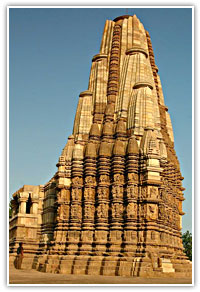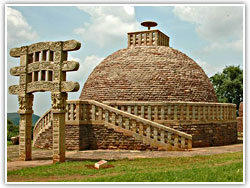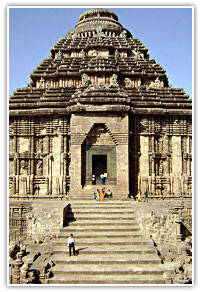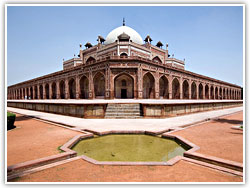|
|
North India Architecture and Sculpture
.............................................................................................................................................................................. |
|
|
|
Indian Architecture is as
ancient as the history of civilization. The
remains of the buildings in India belongs to the
third millennium in the Indus Valley cities. These
cities are among the man’s earliest attempts to
built the urban environment. "The Great Baths of Mohenjodaro" are some of the significant examples
of architecture. Later, the Vedic period was
marked by the unspecified pastoral settlements of
mud, thatch, bamboo and timber in the valleys of Ganga and Saraswati. Even though the examples of
perishable timber structures of that period are
not available, but the facts are based on
evidences left by successive Buddhist sculptures
of the 2nd and 3rd century BC. These sculptures
depict the episodes from the life of Buddha, in
the architectural setting of the Vedic period. The
story of Indian art begins with Harappan culture.
The Harappans were great builders, skilled in town
planning. The houses with the various |
 |
|
|
facilities, the granaries, the Great
Bath, show how skilful and efficient the people were in
construction. The terracotta and stone images, the
bronze figure of the dancing girl and the artistic seals
reveal the exquisite workmanship of the artists.
The Hindu Temples
The Hindu Temples are the most unique temples among the
India’s prehistoric monuments. The Indian temples were
built mostly at the places which could be approached by
a large number of people, like at centers of pilgrimage,
near a river, lake or a man-made tank as the water was
needed by the worshippers for ablutions. The symbolic
meaning can be viewed in the architecture of the temple
with its three elements, namely, the base, the walls and
the spire, which correspond to Earth, Space and Heaven.
In other words, it represents the Feet, the Body and the
Head of the Cosmic Man. The temple is regarded as the
Universe in microcosm where devotees make offerings to
the god enshrined within the temple. These temples,
either large or small, can be easily recognized by the
typical pyramidal spire, which can be easily seen in the
temples of South India. Kanchipuram, Madurai, Srirangam,
Rameshwaram are the famous pilgrimage centres in the
South India. In the North, these temples can be compared
only with the Hindu temples situated in Varanasi, one of
the famous ancient and holiest city of the Hindus. The
Hindu temples were destroyed by the Muslim invaders, and
presently Varanasi has hardly any monuments left that
were built in the ancient past. The occurrence of floods
also added to the devastation. Some of the famous
temples which have survived in North India are located
in isolated places like the Khajuraho in Madhya Pradesh,
and Bhubhaneshwar and Konark in Orissa. |
|
|
|
The Stupas
The religion Buddhism became the principal
religion of India around the 2nd to 3rd century
BC. In this era, stone was also introduced for the
first time in Indian art and architecture. The
Buddhist Stupas are supposed to be much older than
the Hindu temples. The Stupas are mound-shaped and
preserve the relics either of the Buddha or of a
great figure of the Buddhist church. Since the
Stupas are identified with the subtle body of the
Buddha, so they are comparable to a temple. In the
|
 |
|
|
initial
stage, the stupa evolved into an elaborate structure
with beautiful sculpture enhancing the encircling
balustrades and the gateways. The Stupa at Sanchi is one
of the finest and impressive example of the sculptures,
that belongs to the 3rd century BC. Incidents from the
life of Buddha are illustrated together with the various
deities of the folk religion. Another artistic
achievement of this period is the famous stupa at Sanchi.
In every stupa there was a small camber in which a
casket with relics of the Buddha or the Buddhist monks
were placed. The surface of the stupa was generally
built of bricks with a thick layer of plaster. The stupa
was crowned by an umbrella of stone. The monument was
surrounded by a fence with a path provided for
Pradakshina (circumambulation). The original stupas were
enlarged and beautified from time to time. The Sanchi
stupa which still stands intact is a well-preserved and
splendid monument. A number of lesser stupas and other
buildings such as monasteries and rest-houses are found
in and around the main stupa. The stupa at Sanchi as it
stands today has stone railings and gateways around it.
These were added later after the Mauryas. The gateways
are a very striking feature. There are four gateways at
the four cardinal points and they contain very lively
and beautifully carved panels. In these panels are
depicted events from the life of the Buddha and details
from the Jataka stories. They also depict a landscape of
trees and floral designs, groups of animals and birds,
beautiful figures of yakshas and yakshinis, and men and
women. Thus the Sanchi reliefs present the story of the
Buddha and provide glimpses into Indian life through
clear, simple and dramatic scenes. The Buddha is
depicted in these panels not through his image but
through the use of various symbols; for example, the
horse represents his ‘renunciation’, the ‘boddhi’ tree
his enlightenment.
Mauryan Sculpture
The ancient remains of the Indus valley culture
discovered in India, are those of the Mauryan period
which existed between 322-185 BC. The best specimen of
the Mauryan stone sculpture, which can be seen in many
museums of India, had a rare feeling for monumental form
and royal power. The sculpture has an exquisite finish
and a brilliant polish that has not lost its shine even
after many years of existence. Among Mauryan sculptures
is the Lion Capital in the Sarnath Museum which has been
adopted as the State seal of India. Numerous Several
Buddhist as well as Jain stupas were also built at
Mathura during the rule of the Kushan from 1st-2nd
century. The Mauryan period was a period of economic
prosperity, important development in religious thinking
and practice and also one of remarkable artistic
achievements. Megasthenes, who came to India as the
ambassador of the Greek ruler Seleucus, described the
palace of Chandragupta Maurya in glowing terms. It was
large and luxurious and built of carver wood. The
earliest stone buildings were based on wooden models.
The monolithic pillars of Ashoka on which are inscribed
his famous edicts are the great monuments of the Mauryan
age. Some scholars trace these pillars to the influence
of Persia. The most striking feature of these pillars is
the finely carved capital with magnificent animal
figures. We are all familiar with Sarnath lion capital
which forms part of India’s National Emblem. The
Rampurva Bull capital is one of the best specimens of
animal sculpture. The polish and smoothness of these
pillars are amazing.
Gandhara and Mathura Schools of Art
The next important stage in the growth of art is
associated with the name of Gandhara in the north-west.
By this time the worship of the image of Buddha had
become common. After the Greek invasions and during the
period of the Kushanas, many artists from West Asia had
settled down in the north – west of India. They were
deeply influenced by the Graeco-Roaman art. Mahayana
Buddhism encouraged image worship. The Kushana kings,
particularly Kanishaka, encouraged the Gandhara artists
to sculpture themes from Buddha’s life and the Jatakas.
The distinctive school of art which grew here is called
the Gandhara school of art. A large number of the images
of the Buddha and the Bodhisattavas were produced.
Another school of art to develop in the early centuries
of the Christian era is that of Mathura. From the
beginning of the Christian era, Mathura became an
important center of artistic activities and the figures
of the Buddha and the Bodhisattavas were produced there.
The fine qualities of indigenous art traditions were
preserved and improved upon by the Mathura sculptors.
The images produced here became the models for the
succeeding generations of artists. This was also the
period of the growth of art in developed under the
Satavahana kings. Like the stupa at Sanchi, there was a
great stupa in Amaravati in the lower Godavari valley.
The stupa has disappeared but many of its fine pieces
are still intact in various museums. Many bas-relief
medallions and paneled friezes decorated the stupa.
These, like the stupa at Sanchi, depict events from the
life of the Buddha and the Jataka stories. One of these
depicts the story of the taming of the elephant by the
Buddha. A rogue-elephant was let loose to kill the
Buddha while he was walking along the streets of
Rajagriha. The panel shows the elephant rushing through
the streets, the panic it caused, the reactions of men
and women and finally the elephant kneeling before the
Buddha. The climax, is portrayed subtly and Pallavas of
the Deccan and southern India added magnificent
monuments, both caves and structural temples. |
|
|
|
North Indian Temples
As in southern India, several styles of temple
architecture developed in northern India. Some of
the most magnificent temples were built in Orissa.
The Lingaraja temple of Bhubaneswar is located in
an extensive area, with a number of subsidiary
shrines. The spire of the Lingaraja temple is
about 40 meters high and is very impressive. The
immense spire is curved and has a rounded top.
Though there are many similarities between these
and the temples in the south, the differences in
style are striking. The sun temple in Konarak,
popularly known as the ‘black pagoda’, perhaps
because of the black stone used, is unique in
design. Since it is dedicated to the sun god, the
whole temple is designed as a chariot with twelve
massive wheels drawn by seven horses. Each wheel
with its rich carvings is a masterpiece. The human
and animal figures carved out in black stone are
most |
 |
|
|
lifelike. The poses of dancing apsaras depicted in
sculptures are studied by dancers even today and are
brought alive by them in their performances. The theme
of several of these sculptures is amorous. The Chandella
rulers of central India built the great temples of
Khajuraho. The built the great temples of Khajuraho. The
shikhara of these temples is graceful and refined and is
adorned with sculptures. The style of the shikhara
varies from that of the others. The sculptures in
Konarak and Khajuraho are some of the finest in India.
They are full of life and vitality. The Jain temples at
Mount Abu are the finest monuments of the Solanki kings
of Gujarat who were great patrons of art. The prosperous
trade brought in wealth that was used for building Hindu
and Jain temples. The Abu temples are very attractive
because of the delicate and intricate carvings in white
marble.
Architecture under the Sultanat
The Turkish rulers utilized the services of the local
designers and craftsmen who were among the most skilful
in the world. The new fusion that started to take place
avoided the extreme simplicity of the Islamic
architecture and the lavish decoration of the earlier
Indian architecture. Among the first buildings to be
erected were the mosques at Delhi and Ajmer by
Qutb-ud-din Aibak. The mosque built in Delhi was called
the Quwwat-ul-Islam mosque. It measured about 70 x 30
meters. The central arch of this mosque which is
decorated with beautiful sculptured calligraphy still
stands and is about 17 meters high and about 7 meters
wide. The successor of Qutb-ud-din, Iltutmish, was a
great builder. He further extended the mosque. He also
completed the the building of the Qutb Minar which had
been started by Qutb-ud-din and now stood in the
extended courtyard of the mosque. This is a tower rising
to a height of about 70 metres and is one of the most
renowned monuments of India. The next important
buildings belong to the reign of Al-ud-din Khalji. He
enlarged the Quwwat-ul-Islam mosque still further and
built a gateway to the enclosure of the mosque, the Alai
Darwaza. Decorative element was introduced to beautify
the building. He also started building a minar which was
designed to be double the height of Qutub Minar, but the
project remained unfulfilled. The Tughlaqs who came
after the Khaljis concentrated on the building of new
cities in Delhi like Tughlaqabad, Jahanpanah and
Feozabad. A number of buildings were erected which
differed in their style from the earlier buildings.
Massive and strong structures like the tomb of
Ghiyasuddin Tughlaq and the walls of Tughlaqabad were
built. The buildings of the Tughlaq period were
significant from the point of view of the development of
architecture. They were not beautiful but massive and
very impressive.
Architecture in the Regional Kingdoms
The regional kingdoms, building on the achievements of
the previous period, developed their own distinctive
styles of architecture. The process of synthesis
continued in these kingdoms also and resulted in the
construction of some of the finest buildings in India.
In Bengal were built the Adina mosque and the tomb of
Jalal-ud-din Muhammad Shah at Pandua and the Dakhil
Darwaza and Tantipara mosque at Gaur. The oblong shape
of many structures and the peculiar style of roof
constructions were some of the distinctive features of
the regional architecture of Bengal. In Jaunpur, the
Sharqi kings built an impressive monument, the Atala
mosque. A huge massive screen covers the dome. The walls
and the ceilings are decorated with many ancient Indian
designs like the lotus. The rulers of Gujarat built many
structures notable for their grandeur and excellence of
their carving and other decorative forms. Ahmad Shah,
the founder of Ahmedabad is the Sadi Saiyyid mosque
popularly known as the Jaliwali Masjid. The delicacy of
the work is evident from the screens. Mahmud Begarha
built the imposing Jama Masjid at Champaner. The
buildings at Mandu developed a distinctive style of
their own under the Sultans of Malwa. Here were built
the Jama Masjid, the Hindola Mahal, the Jahaz Mahal and
a number of tombs. The buildings of Malwa have wide and
imposing arches and the windows are gracefully
decorated. The tomb of Hoshang Shah is made entirely of
marble, the first o its kind in India, and is delicately
decorated with yellow and black marble inlay work. The
rulers of Kashmir also built many beautiful buildings.
Timber, stone and brick were used in the Jama Masjid
completed by Sultan Zain-ul-Abidin. The turret is a
striking feature of the mosques of Kashmir and recalls
to mind of brick and glazed tiles, has been designed in
the Persian style. The Bahmani Sultans in the Deccan
erected a number of buildings in a distinctive style at
Bidar and Gubarga. They borroed from the styles of
Persia, Syria, Turkey and those of the temples of
southern India. The Jama Masjid in Gulbarga is quite
well known. The courtyard of this mosque is covered with
a large number of domes. It is the only mosque in India
which has a covered courtyard. Instead of minarets,
there are domes at the four corners and a fifth and
bigger one above the prayer chamber. The absence of
decorative work does not mar its grandeur. There are two
groups of tombs. The first group has the tombs of the
first two Sultans and shows the impress of Tughlaq
architecture. The second group called the halft gumbad
or ‘seven tombs’ shows the influence of Persian and
ancient Indian styles. Bidar also has a number of tombs.
The tomb of Sultan Ahmad Shah Ali is richly decorated
with beautiful paintings. The finest monument at Bidar
is the madrasa of Mahmud Gavan, the great minister of
the Bahmani Kingdom for many years. It is a three-storeyed
building and has two towering minars at the front
corners. After the Bahmani kingdom was split up, many
other buildings, such as the Mehtar Mahal and the
Ibrahim Rauza, were erected in the new principalities.
The Gol Gumbaz, which is one of the largest domes in the
world, at Bijapur, and the for of Golconda, which is one
of the strongest in India, and many tombs in Golconda
also belong to this period. These regional kingdoms, in
the north and the south, played a significant role in
the development of a common culture. |
|
|
|
The Mughal Architecture
The process of synthesis was completed under the
Mughals and the new architecture which had started
taking shape with the establishment of the
Sultanat reached the pinnacle of glory. The
achievements of the Mughal period are the finest
in architecture as well as in other fields of
culture and can be very well compared with any
preceding age in Indian history.
Babur and Humayun, the first two Mughal |
 |
|
|
kings, erected a number of buildings
with the help of Persian architects and these, now in
ruins, are not very impressive. Humayun had to flee the
country in the face of the rising power of the Afghan
ruler, Sher Shah Suri. There was a short interregnum of
Afghan rule before Hummayun recovered the Indian
territories for the Mughals. The most important building
erected during the Afghan interregnum is the mausoleum
of Sher Shah at Sasaram. The mausoleum is a
well-proportioned building and stands in the middle of a
tank. The Mughal architecture, properly speaking, began
in the reign of Akbar. The first important building of
Akbar’s reign is Humayun’s tomb at Delhi. In this
magnificent tomb, the Persian influence is very strong,
particularly in the construction of the dome. However,
unlike the Persians’ use of bricks and glazed tiles, the
Indian builders of the tomb used stone and marble. The
two significant features of the Mughal architecture are
also evident here – the large gateways and the placement
of the building in the midst of a large park. The tomb
provided many architectural ideas for the building of
the Taj Mahal later.
The next important buildings erected
under Akbar were the forts at Agra and Lahore. He built
his palace within the Agra fort. Many new buildings were
constructed in the fort and perhaps the old ones altered
by Akbar’s successors. However, the parts attributed to
Akbar’s reign were built under the strong influence of
the ancient Indian style and have courtyards and
pillars. For the first time in the architecture of this
style, living beings-elephants, lions, peacocks and
other birds – were sculptured in the brackets. The
crowning achievement of the reign of Akbar was the
building of his new capital at Fatehpur Sikri, about 40
km from Agra. The buildings at Fatehpur Sikri have been
built in a variety of styles making it one of the most
magnificent capitals in the world. It had a
circumference of over 10 kilometers. Even now there
exist a number of magnificent structures in Fatehpur
Sikri. The arch of the Buland Darwaza is about 41 metres
high and is perhaps the most imposing gateway in the
world. The tomb of Salim Chishti built in white marble
is exquisite in its beauty. The building popularly known
as the palace of Jodha Bai was built in the style of
ancient Indian architecture. The Jami Masjid shows the
influence of the Persian style. The cloisters
surrounding it have a large number of domes and rooms.
The Diwan-I-aam and the Diwan-I-khas are remarkable
buildings and their planning and decoration have a
unique Indian style. Birbal’s house is profusely
sculptured with beautiful patterns. Another notable
building is the Ibadat – Khana or the ‘House of Worship’
where learned people belonging to various religions
gathered together and discussed questions of philosophy
and theology in the presence of the emperor. Then there
is the Panch Mahal, a five-storeyed building modeled
perhaps on the Buddhist Viharas (Viharas are like
monasteries where normally wandering Buddhist monks
would reside).
During the reign of Jahangir, the mausoleum of Akbar was
constructed at Sikandara. This is a magnificent monument
in many ways. After a long time, the Minar became
architecturally significant here. It has beautiful
arches and domes. But the whole structure, as Ferguson
suggested, is inspired by the Buddhist viharas. Jahangir
also extended the palace buildings in the Agra fort and
built the beautiful tomb of Itmad-ud-daula, the father
of Nur Jahan. The tomb was built in marble and is
notable for its beautiful colored inlay work. Jahangir’s
wife Nur Jahan built a beautiful mausoleum for her
husband at Shahdara near Lahore.
The greatest of the Mughal builders was Shah Jahan, the
successor of Jahangir. His reign marks the highest
development of Mughal architecture. Some of the finest
monuments of our country were built during his reign.
Under him we find an exceedingly liberal use of marble,
delicate decorative designs, a variety of arches and
beautiful minarets. The list of Shah Jahan’s buildings
is very large – the completion of a large number of
buildings in the Agra fort, the city of Shahjahanabad
and the Red fort of Delhi with its many buildings, the
Jama Masjid at Delhi, the Taj Mahal and many others.
Only a brief description of these buildings is possible
here. The Diwan-I- Aam and the Moti Masjid in the Agra
fort are built mainly in white marble with beautiful
colored inlay work. The Diwan-I-khas and the Diwan-I-Aam
in the Red fort are richly decorated and are works of
great beauty. The Diwan- I -khas rightly bears the
inscription: Agar firdaus barrooe zaminast-haminasto
haminasto haminasto (if there is a paradise on earth, it
is here, it is here). The Red Fort has become associated
with the history of our country during the past 350
years and it is here that the national flag was unfurled
on the day after India became free. The Jama Masjid at
Delhi with its imposing domes and minarets is the most
famous mosque in the country and one of the finest in
the world. The most magnificent of Shah Jahan’s
buildings is the Taj Mahal built in memory of his wife,
Mumtaz Mahal. It represents India’s culture at its best
and has been aptly described as ‘ the dream in marble’.
It is remarkably well conceived and all its parts – the
gateways, the central dome, the elegant minars, the
delicate decoration, the inlay work in colored marbles
and precious stones, the lovely gardens surrounding it
and the fountains in front- have been perfectly
executed. The only notable buildings of the reign of
Aurangzeb, the last of the great Mughals, are the
Badshahi mosque at Lahore and the Moti Masjid at Delhi.
The period after him is one of general decline. A
significant contribution of the Mughals, especially
Jahangir, was the laying of gardens. Some of the finest
gardens were laid by him in Lahore and Srinagar. The new
style of architecture had significant influence on the
construction of Hindu temples and the secular buildings
of the Rajputs during this period. |
|